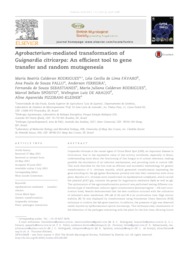Agrobacterium-mediated transformation of Guignardia citricarpa: an efficient tool to gene transfer and random mutagenesis.
Agrobacterium-mediated transformation of Guignardia citricarpa: an efficient tool to gene transfer and random mutagenesis.
Autoria: RODRIGUES, M. B. C.; FAVARO, L. C. de L.; PALLU, A. P. de S.; FERREIRA, A.; SEBASTIANES, F. de S.; RODRIGUES, M. J. C.; SPÓSITO, M. B.; ARAÚJO, W. L. de; PIZZIRANI-KLEINER, A. A.
Resumo: Guignardia citricarpa is the causal agent of Citrus Black Spot (CBS), an important disease in Citriculture. Due to the expressive value of this activity worldwide, especially in Brazil, understanding more about the functioning of this fungus is of utmost relevance, making possible the elucidation of its infection mechanisms, and providing tools to control CBS. This work describes for the first time an efficient and successful methodology for genetic transformation of G. citricarpa mycelia, which generated transformants expressing the gene encoding for the gfp (green fluorescent protein) and also their interaction with citrus plant. Mycelia of G. citricarpa were transformed via Agrobacterium tumefaciens, which carried the plasmid pFAT-gfp, contains the genes for hygromycin resistance (hph) as well as gfp. The optimization of the agrotransformation protocol was performed testing different conditions (type of membrane; inductor agent concentration [acetosyringonee - AS] and cocultivation time). Results demonstrated that the best condition occurred with the utilization of cellulose?s ester membrane; 200µM of AS and 96 h as cocultivation time. High mitotic stability (82 %) was displayed by transformants using Polymerase Chain Reaction (PCR) technique to confirm the hph gene insertion. In addition, the presence of gfp was observed inside mycelia by epifluorescence optical microscopy. This technique easy visualization of the behaviour of the pathogen interacting with the plant for the first time, allowing future studies on the pathogenesis of this fungus. The establishment of a transformation method for G. citricarpa opens a range of possibilities and facilitates the study of insertional mutagenesis and genetic knockouts, in order to identify the most important genes involved in the pathogenesis mechanisms and plant-pathogen interaction.
Ano de publicação: 2013
Tipo de publicação: Artigo de periódico
Unidade: Embrapa Agrossilvipastoril
Observações
1 - Por padrão são exibidas publicações dos últimos 20 anos. Para encontrar publicações mais antigas, configure o filtro ano de publicação, colocando o ano a partir do qual você deseja encontrar publicações. O filtro está na coluna da esquerda na busca acima.
2 - Para ler algumas publicações da Embrapa (apenas as que estão em formato ePub), é necessário ter, no celular ou computador, um desses softwares gratuitos. Sistemas Android: Google Play Livros; IOS: iBooks; Windows e Linux: software Calibre.
Acesse outras publicações
Acesse a Base de Dados da Pesquisa Agropecuária (BDPA) para consultar o acervo completo das bibliotecas da Embrapa.

